
A group of Josai University Educational Corporation consisting of 6 members led by Chancellor Noriko Mizuta has recently visited Sweden from October 5 to 11, 2014.
The main destinations were the residence of the ambassador of Sweden to Japan, the Museum of Ethnography, Zui-Ki-Tei, Karolinska Institutet and its hospital, Moderna Museet in Stockholm, the Museum of Far Eastern Antiquities, European Institute of Japanese Studies in the Stockholm School of Economics, and Uppsala University.
Dr. Lars Vargö, who is a former ambassador to Japan, introduced each destination and accompanied the group. The group met with Ambassador Seiji Morimoto of Japan to Sweden, President Kaj Falkman of Svensk-Japanska Sällskapet, Director Marie Söderberg of the European Institute of Japanese Studies in the Stockholm School of Economics, Chancellor Eva Åkesson of Uppsala University, etc. and we were able to make significant progresses in the development of academic exchanges between Sweden and Josai University Educational Corporation.
In addition, the Nobel Prize in Physics was attributed while the group was visiting the ambassador’s residence, and we were able to celebrate the nomination of a Japanese national with the ambassador and board members of Svensk-Japanska Sällskapet.
We hope to develop the exchanges with each university and institute in the future and promote productive activities in preparation for the 150th anniversary of Swedish – Japanese exchanges in 2018.
We visited the residence of ambassador of Japan to Sweden from 12pm on October 7 (Tuesday). The Nobel Prize in Physics was announced on the same day, and we had the honor of receiving the newsflash about the nomination of a Japanese national from Ambassador Extraordinary and Plenipotentiary of Japan to Sweden Seiji Morimoto. This was a memorable moment for Chancellor Mizuta, who is the president of the Japan-Sweden Society, and Ambassador Morimoto to meet at the ambassador’s residence on the day of the Nobel Prize announcement. This was a memorable day to build a momentum for further international exchanges between the two countries in the future.
Since the Japan-Sweden Society has also asked Japanese people, who were nominated for Nobel Prizes, to become honorable members in order to promote academic and cultural exchanges between Japan and Sweden, this turned out to be a day that enabled us to have more hopes for further exchanges between the two countries.
A lunch reception was hosted by Ambassador Morimoto, and board members of Svensk-Japanska Sällskapet in Sweden, including former Ambassador Lars Vargö of Sweden to Japan and former Counsellor Kaj Reinius, participated in the reception to meet Chancellor Mizuta on her trip to Sweden. Opinions were actively exchanged throughout the reception regarding future promotion of cultural exchanges, cultural exchanges for young generations, and academic exchanges, between the two countries that will celebrate the 150th anniversary of Swedish – Japanese exchanges in 2018. We made a promise to make efforts to further deepen the relationship in the future.
|
With Ambassador Morimoto, holding the press release |
With members of the Svensk-Japanska Sällskapet in |
We visited the tea house that was donated to the Swedish National Museum of Ethnography by Ginjiro Fujiwara, who was the president of Swedish-Japanese Association, in 1935. “Zui-Ki-Tei” burned down in 1969 but was re-built with the donation of 4 paper manufacturers in Japan in 1989 and donated to the Museum of Ethnography again. In response to the recent appointment as the president of the Japan-Sweden Society, Chancellor Mizuta visited the tea house to consider its maintenance, utilization methods, etc. in preparation for the 150th anniversary year of Swedish – Japanese exchanges in 2018 in the future.
On the day of the visit, Lotten Gustafsson Renius, who is the curator of Museum of Ethnography, also joined us and guided us through the Japan area. Afterwards, former President Yu Komaki of the Japanese Society and President Yoko Kaneko of the Japanese Society guided us, and we had the honor of having the tea made by the members of Swedish Uasenke in Zui-Ki-Tei. The tea ceremony, which was held while beautiful autumn leaves fell around us, left a strong impression. This is a valuable tea house, so we hope to consider how we can effectively utilize it to disseminate Japanese culture.
|
Being guided through the JAPAN area in |
At Zui-Ki-Tei |
Kenji Sugibayashi and Tomoko Sano met Professor Hideo Akutsu (honorary professor of Osaka University), who is the director of the office.
This facility is an academic exchange support organization for 5 North European countries, 3 Baltic countries, and Japan. Since it was the announcement date for the Nobel Prize in Chemistry on the day of our visit, other employees were absent. However, Director Akutsu himself gave us thorough explanations on the works of the JSPS Stockholm Office.
The office not only handles researcher exchanges with Japan but also works on promoting student exchanges with Japan. However, he said that the JSPS Stockholm Office still has not been able to establish a foothold for Norway. Due to the fact that JIU hosts 20 students from University of Oslo every year, it is possible that we may be able to establish an alliance with the JSPS Stockholm Office.
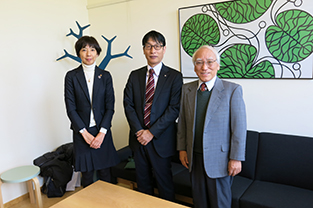
With Director Hideo Akutsu of JSPS Stockholm Office
Although it is named an institute, it is actually a medical university where the nomination committee for the Nobel Prize in Physiology or Medicine is located. This beautiful campus is made of bricks, which is suitable for the biggest campus in the world and the institute that represents Europe. Nobel Memorial Hall is located at the entrance, and we were informed that a number of related lectures are held in the hall. This is currently the leading medical university in Sweden.
We also visited Karolinska University Hospital. The comprehensive reception was located inside of the entrance, and a bright restaurant (cafeteria) was behind it. Possibly because we visited around lunch time, there were many people having lunch. The convenience store in the hospital was also bright. The great difference from the first floor of Japanese hospitals left a strong impression on us.
We also visited the pharmacy in front of the hospital. It not only had the prescription reception and the dispensing facility but also had the drugstore section offering general medical goods, cosmetics, etc. Japanese dispensing pharmacies rarely have OTC, etc. (Essentially, it is desirable for pharmacies to be able to dispense medical pharmaceutical products and offer general medical goods and health maintenance-related miscellaneous goods.) There was a lot for us to learn there.
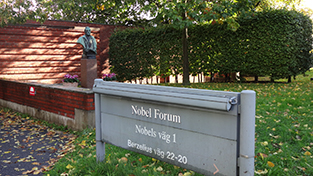
Building affiliated to the Nobel Prize within the city of Karolinska
|
Entrance to the Karolinska University Hospital |
1st floor of the Karolinska University Hospital |
Stockholm University consists of a main campus made of a number of big modern buildings and another campus with brick buildings scattered around the campus. The School of Japanese is located on the latter campus, and approximately 150 students were learning Japanese. The school is of similar size as the School of Japanese in the University of Warsaw, which Professor Sugibayashi visited in June of this year.
We met President Kaj Falkman of Svensk-Japanska Sällskapet, who is a former ambassador to Japan and President of Swedish Haiku Society, in the beautiful restaurant in the Museum of Far Eastern Antiquities that overlooks the lake. He has an extensive knowledge of many different literary cultures including Japanese literature and history and told us many interesting stories. Afterwards, he guided us through the Chinese, Korean, and Japanese exhibition areas in the Museum of Far Eastern Antiquities. He then guided us through the Modern Museum, in which contemporary art was displayed.
|
The Museum of Far Eastern Antiquities |
President Falkman of Svensk-Japanska Sällskapet and |
We visited the office of Professor Marie Söderberg in the Stockholm School of Economics, which is located in Stockholm. Professor Söderberg currently serves as the director of the European Institute of Japanese Studies. The Stockholm School of Economics was established in 1909 and is a college with a long history. It is also known as the school in which both Heckscher and Ohlin of the Heckscher–Ohlin model, which is well-known in the field of international economy, taught. It is also globally-known as a research institute that greatly affects the attribution of the Nobel Memorial Prize in Economics.
During the meeting with Professor Söderberg, opinions were exchanged over a wide range of topics, such as the roles of the European Institute of Japanese Studies in the EU, recent Japanese economic society, etc. Chancellor Mizuta introduced issues of women’s advancement into Japanese society, roles of women in households, etc. Professor Söderberg introduced cases in which fewer women are still appointed as corporate officers in companies in Sweden, in which women’s advancement into society has developed socially, etc.
It was decided that we will continue to exchange opinions and hold discussions regarding exchanges between the universities in the future in order to promote the exchanges between Josai University Educational Corporation and Stockholm School of Economics. Josai University and Josai International University have as many as 3 departments in the fields of economy/management with a number of students and faculty members. We concluded the visit after confirming that we will discuss specifics of academic exchanges with Stockholm School of Economics in the future and promote the exchanges.
|
Meeting at the European Institute of Japanese Studies in |
Visiting the campus which holds the |
We headed to Uppsala, which is the 4th biggest city (population of slightly over 200,000) in Sweden located 70km from Stockholm and visited Uppsala University. Uppsala University was established in 1477 and is the oldest university in North Europe with over 40,000 students, offering 9 faculties of theology, law, medicine, pharmacy, science, languages, educational sciences, social sciences, and art.
We met Chancellor Eva Åkesson in the “Linnaeus’s Room”. We introduced our school and discussed the possibility of exchanges between the two universities. Due to the fact that the meeting was between two female top persons, Chancellor Åkesson expressed strong interests toward the recent development of women’s studies and women’s active roles in Japan. This conversation was followed by a friendly discussion regarding exchanges of faculty members/students in the medical/welfare fields and language/art fields, etc. over lunch.
|
In Linnaeus’s Room with the chancellor of Uppsala University and former Ambassador Vargö of Sweden |
Commemorative photo with the chancellor of |
There are 12 libraries in the oldest university in Northern Europe. We were guided to the oldest library area, which is the main library area. A museum is located on the first floor of the building, exhibiting a number of valuable pieces, including a bible made of silver, a musical score of “Die Zauberflöte” by Mozart, etc. Other areas are modern browsing rooms for students, and many students were entering and leaving the areas.
When we went to the 6th floor, book shelves were filled with beautiful manuscripts which have been collected since the establishment of the university in 1477. Since Uppsala University is renowned as Linnaeus’s university, a number of old biology/plant/flower-related materials have also been collected from all over the world. On this visit, they made an exception and showed us Harry Martinson’s drawings, letters, journals, etc. to celebrate the fact that Chancellor Mizuta is an awardee of the Cikada Prize. There was also a part of the journal where he was inspired with an image for the work, for which he received the Nobel Prize in Literature, and we were deeply moved.
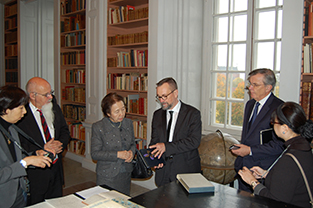
With writings of Harry Martinson’s in hand at the CAROLINA REDIVIVA of Uppsala University
A lunch meeting was held regarding specific exchanges between the two universities, and was attended by the Chair at the Department of Literature, professor at the Department of Literature, and section director at Student Affairs and Academic Registry Division, International Office.
First, Josai University Educational Corporation introduced the past relationship between Josai University Educational Corporation and Sweden with examples of the Mai Zetterling-project, tree planting ceremony in honor of Raoul Wallenberg, lecture by the former Ambassador Vargö, International Symposium Commemorating Winning of the Cikada Prize, etc. and deepened mutual understanding.
Uppsala University told us that there are many students in Sweden who wish to learn Japanese due to the influence of Japanese pop culture. We explained the exceptional Japanese education and exchange program in Josai University Educational Corporation. At the same time, we also mentioned student’s opportunities to learn about Japanese culture in the Faculty of Media Studies the Faculty of International Humanities as well as our “Global College” program, in which classes are taught in English.
Uppsala University also asked us about the possibility of internships for students. We explained that we have implemented internships on Japanese teaching method in the University of Oslo, and they expressed great interests.
In addition, Chancellor Mizuta also made proposals regarding student exchanges, Swedish classes, and dispatching of faculty members. We look forward to future exchanges.
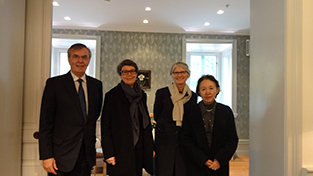
The lunch meeting at Uppsala University
When we entered the hospital, there were an open café and convenience store in a bright atmosphere just like Karolinska University Hospital, and many people were utilizing the facilities.
Dr. Mikael Köhler, who is the head of the Department of Cardiology, guided us through the hospital wings. We visited the emergency care wing, rheumatology wing, and the nephrology wing. Especially in the emergency care wing, there were only curtains separating the hallway and rooms, providing an environment in which the medical team can easily attend to patients. This left a strong impression on us.
Afterwards, we listened to the overview in the seminar room. They explained how each building has different departments and that this hospital especially excels at plastic surgery treatment, etc. After the explanations, a Q&A session was held in connection to the difference of the insurance system between two countries, including differences in medical cost and medical systems in Japan and Sweden, etc.
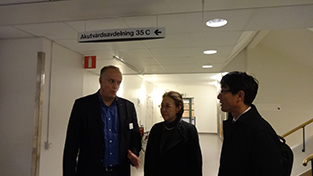
At the Uppsala University Hospital
Between official events, we visited the city hall, which is also used as the dinner venue for Nobel Prize awardees, the Old Town (Gamla stan) with the palace and the parliament building, concert hall where the Nobel Prize ceremonies are held as well as the surrounding urban district, Skansen Open-Air Museum, Vasamuseet, Museum of Far Eastern Antiquities, Moderna Museetm, public and private libraries, Östermalm district, which is a high-end residential area, suburban cities where the rapidly-increasing immigrants from Eastern Europe and other residential areas, the new city Systa, which is called the Silicon Valley of North Europe, Drottningholm Palace, etc. We received a warm welcome and occasional sunlight in the big city, which is called the Venice of North Europe, surrounded by lakes and ocean. The beautiful city of changing leaves left a strong impression on us.
On our way back from the Uppsala visit, they also guided to the elegant house in a suburb, which used to be used as an elementary school, where former Ambassador and Mrs. Vargö have been residing since their return to Sweden. We were able to learn the long history of Sweden and the great nature.

